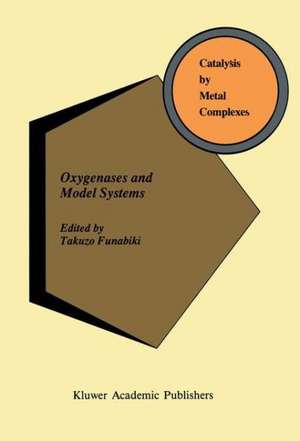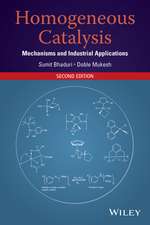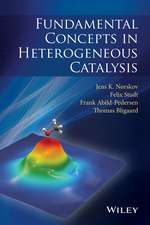Oxygenases and Model Systems: Catalysis by Metal Complexes, cartea 19
Editat de T. Funabikien Limba Engleză Hardback – 31 dec 1996
Audience: Research chemists interested in the use of oxygenases in catalysis.
| Toate formatele și edițiile | Preț | Express |
|---|---|---|
| Paperback (1) | 1043.86 lei 38-44 zile | |
| SPRINGER NETHERLANDS – 12 oct 2012 | 1043.86 lei 38-44 zile | |
| Hardback (1) | 1234.62 lei 6-8 săpt. | |
| SPRINGER NETHERLANDS – 31 dec 1996 | 1234.62 lei 6-8 săpt. |
Din seria Catalysis by Metal Complexes
- 15%
 Preț: 640.06 lei
Preț: 640.06 lei - 15%
 Preț: 589.30 lei
Preț: 589.30 lei - 18%
 Preț: 954.45 lei
Preț: 954.45 lei -
 Preț: 387.75 lei
Preț: 387.75 lei - 18%
 Preț: 1227.36 lei
Preț: 1227.36 lei - 18%
 Preț: 1228.47 lei
Preț: 1228.47 lei - 18%
 Preț: 1832.08 lei
Preț: 1832.08 lei - 18%
 Preț: 1386.62 lei
Preț: 1386.62 lei - 15%
 Preț: 593.89 lei
Preț: 593.89 lei - 15%
 Preț: 644.30 lei
Preț: 644.30 lei -
 Preț: 399.88 lei
Preț: 399.88 lei - 18%
 Preț: 948.16 lei
Preț: 948.16 lei - 18%
 Preț: 1230.53 lei
Preț: 1230.53 lei - 18%
 Preț: 1225.62 lei
Preț: 1225.62 lei - 18%
 Preț: 1229.73 lei
Preț: 1229.73 lei - 18%
 Preț: 944.82 lei
Preț: 944.82 lei - 18%
 Preț: 945.30 lei
Preț: 945.30 lei -
 Preț: 384.31 lei
Preț: 384.31 lei - 18%
 Preț: 958.38 lei
Preț: 958.38 lei - 18%
 Preț: 952.89 lei
Preț: 952.89 lei - 18%
 Preț: 952.40 lei
Preț: 952.40 lei - 18%
 Preț: 946.55 lei
Preț: 946.55 lei - 18%
 Preț: 1113.58 lei
Preț: 1113.58 lei - 18%
 Preț: 948.61 lei
Preț: 948.61 lei - 18%
 Preț: 950.84 lei
Preț: 950.84 lei - 18%
 Preț: 1217.90 lei
Preț: 1217.90 lei
Preț: 1234.62 lei
Preț vechi: 1505.64 lei
-18% Nou
Puncte Express: 1852
Preț estimativ în valută:
236.28€ • 245.76$ • 195.06£
236.28€ • 245.76$ • 195.06£
Carte tipărită la comandă
Livrare economică 14-28 aprilie
Preluare comenzi: 021 569.72.76
Specificații
ISBN-13: 9780792342403
ISBN-10: 0792342402
Pagini: 393
Ilustrații: XIII, 393 p.
Dimensiuni: 152 x 229 x 24 mm
Greutate: 0.93 kg
Ediția:1997
Editura: SPRINGER NETHERLANDS
Colecția Springer
Seria Catalysis by Metal Complexes
Locul publicării:Dordrecht, Netherlands
ISBN-10: 0792342402
Pagini: 393
Ilustrații: XIII, 393 p.
Dimensiuni: 152 x 229 x 24 mm
Greutate: 0.93 kg
Ediția:1997
Editura: SPRINGER NETHERLANDS
Colecția Springer
Seria Catalysis by Metal Complexes
Locul publicării:Dordrecht, Netherlands
Public țintă
ResearchCuprins
1. Introduction — Developments in Enzymatic and Model Studies on Oxygenases.- 1.1. Oxygenases.- 1.2. Oxygenase model s.- 1.3. Biomimetic chemistry and bioinspired catalysis.- 1.4. References.- 2. Dioxygenases.- 2.1. Introduction.- 2.2. Catechol dioxygenases.- 2.3. Other double bond cleaving dioxygenases.- 2.4. Other dioxygenases.- 2.5. Supplement for extradiol cleaving catechol dioxygenases.- 2.6. Concluding remarks.- 2.7. References.- 3. Iron Model Studies on Dioxygenases.- 3.1. Introduction.- 3.2. Catechol dioxygenases.- 3.3. Tryptophan 2,3-dioxygenase.- 3.4. Lipoxygenases.- 3.5. ?-Keto acid-dependent dioxygenases.- 3.6. Supplement for catechol dioxygenases.- 3.7. Concluding remarks.- 3.8. References.- 4. Non-Iron Model Studies on Dioxygenases.- 4.1. Introduction.- 4.2. Cobalt Schiff base complexes as simple dioxygenase models.- 4.3. Co(TPP) catalyzed oxygenation of indoles.- 4.4. Vanadium complexes.- 4.5. Manganese complexes.- 4.6. Copper complexes.- 4.7. Ruthenium, rhodium, iridium complexes.- 4.8. Concluding remarks.- 4.9. References.- 5. Heme Monooxygenases — A Chemical Mechanism for Cytochrome P450 Oxygen Activation —.- 5.1. Introduction.- 5.2. Reaction cycle of cytochrome P450cam.- 5.3. Oxygen bond scission and catalysis.- 5.4. Summary.- 5.5. Acknowledgement.- 5.6. References.- 6. Model Studies on Heme Monooxygenases.- 6.1. Introduction.- 6.2. Successful use of synthetic heme models: Model studies of Fe porphyrin having thiolate ligand.- 6.3. Molecular mechanism of the oxygen activation by P-450.- 6.4. Electrochemical oxidation of iron porphyrin complexes.- 6.5. Mechanistic aspects of compound I formation.- 6.6. O=Mn, O=Cr, and O=Ru porphyrin complexes.- 6.7. Reductive oxygen activation by P-450 models.- 6.8. Catalytic oxidation of organic compoundscatalyzed by iron porphyrins.- 6.9. Catalytic oxidation by manganese porphyrins.- 6.10. Multiplicity of the active species in the catalytic oxidation.- 6.11. Selective oxidations.- 6.12. Metalloporphyrin complexes showing high catalytic efficiency in oxidations.- 6.13. Summary.- 6.14. References.- 7. Nonheme Monooxygenases.- 7.1. Introduction.- 7.2. Nonheme iron monooxygenases.- 7.4. Concluding remarks.- 7.5. References.- 8. Model Studies on Nonheme Monooxygenases — Chemical Models for Nonheme Iron and Copper Monooxygenases —.- 8.1. Introduction.- 8.2. Chemical models for putative reaction intermediates of nonheme iron monooxygenases.- 8.3. Chemical models for copper monooxygenases.- 8.4. References.
Recenzii
` ... the subject is covered in considerable depth and thoroughness and the editor deserves much credit for this. ... the volume is well put together ... has just the right mixture of chemistry and biology to make it of interest and of value to chemists and biochemists alike. I would, therefore, recommend that anybody working in the field should get hold of it, or at least make sure their library has a copy.'
Applied Organometallic Chemistry, 12 (1998)
Applied Organometallic Chemistry, 12 (1998)




